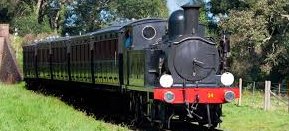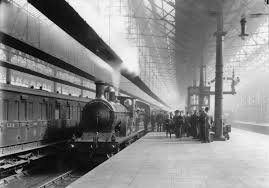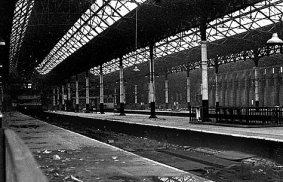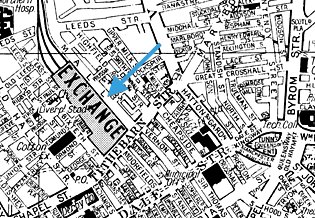Index
- Liverpool to Wigan Home
- Liverpool Exchange
- Great Howard Street
- Sandhills
- Kirkdale
- Rice Lane
- Fazakerley
- Kirkby
- Kirkby Royal Ordnance
- Rainford
- Rainford Junction
- Upholland_1st
- Upholland_2nd
- Orrell
- Pemberton
- Wigan LYR 1st
- Wigan LYR 2nd
- Wigan Wallgate

Liverpool Exchange formerly Liverpool Tithbarn Street
(1850 - 1977)

When opened on May 13 1850, the station served the East Lancashire Railway’s (ELR) line to Preston, the Lancashire & Yorkshire Railway’s (LYR) route to Bolton and the Liverpool,
Crosby & Southport Railway (LC&SR). The LYR company called it Liverpool Exchange station and the East Lancs Company called it Tithebarn Street station. On August 13 1859, the LYR absorbed
the ELR and from that date the only name of the station was Liverpool Exchange
The station was elevated above street level on brick arches. The frontage towered 90ft above the street because the lines approaching the station had to clear the Leeds & Liverpool Canal. From Tithebarn Street ornamental steps and a 30ft-wide driveway sloped up to the frontage. The building was stone-built, consisted of two storeys, Within the building were booking offices for both the LYR and the ELR. At right-angles to the building there were two single-storey wings which contained refreshment rooms and waiting facilities for both companies. There was one arrival platform and two departure platforms - one for each company
By the 1880s traffic levels at Liverpool Exchange had built up to such a degree that further expansion was needed and the station would be lowered from its original elevated position. The new facilities opened completely July 2 1888. On August 13 1888 the Exchange Hotel,which provided the frontage to the station, opened
Steps led into the main area of the station; either side of them there were brick-built offices, refreshment rooms, parcels offices and staff accommodation. There were ten platforms beneath a ridged iron glazed roof that allowed light into the station. The platform faces were arranged as six ‘islands’. Between platforms 3 and 4 was a wide roadway for road vehicles to collect and deliver goods and parcels. To the south of the platforms, were two timber booking offices, one to the east and the other to the west. The western office sold tickets for local services whilst the eastern one catered for long-distance passengers. In 1888 Liverpool Exchange had 115 departures and 115 arrivals which the new facilities easily accommodated
Southport traffic had increased to such a degree that it taxed the accommodation at Liverpool Exchange to the limit. The solution proposed by LYR was to electrify the route to Southport and from April 5 1904 the Southport line passenger services went completely electric. The service was a great success and there were 119 departures from Liverpool Exchange to Southport
The Liverpool Blitz began on August 9 1940. The city’s railways were a target for enemy bombers and damage was caused to the approach lines to Liverpool Exchange
In Summer 1960, there were 179 departures from the station but by March 1967 platforms 1, 2 and 3 had been taken out of use and the tracks were removed and the area was infilled and used for car parking. This was the start of closures for most of the services from Liverpool Exchange leaving electrified services to Ormskirk and Southport and it was decided that a new underground station would be provided at Moorfields to replace Exchange station for these services
The last train left Liverpool Exchange on April 29 1977 for Liverpool Lime Street (a mile away) via Wigan Wallgate

The station was elevated above street level on brick arches. The frontage towered 90ft above the street because the lines approaching the station had to clear the Leeds & Liverpool Canal. From Tithebarn Street ornamental steps and a 30ft-wide driveway sloped up to the frontage. The building was stone-built, consisted of two storeys, Within the building were booking offices for both the LYR and the ELR. At right-angles to the building there were two single-storey wings which contained refreshment rooms and waiting facilities for both companies. There was one arrival platform and two departure platforms - one for each company
By the 1880s traffic levels at Liverpool Exchange had built up to such a degree that further expansion was needed and the station would be lowered from its original elevated position. The new facilities opened completely July 2 1888. On August 13 1888 the Exchange Hotel,which provided the frontage to the station, opened
Steps led into the main area of the station; either side of them there were brick-built offices, refreshment rooms, parcels offices and staff accommodation. There were ten platforms beneath a ridged iron glazed roof that allowed light into the station. The platform faces were arranged as six ‘islands’. Between platforms 3 and 4 was a wide roadway for road vehicles to collect and deliver goods and parcels. To the south of the platforms, were two timber booking offices, one to the east and the other to the west. The western office sold tickets for local services whilst the eastern one catered for long-distance passengers. In 1888 Liverpool Exchange had 115 departures and 115 arrivals which the new facilities easily accommodated
Southport traffic had increased to such a degree that it taxed the accommodation at Liverpool Exchange to the limit. The solution proposed by LYR was to electrify the route to Southport and from April 5 1904 the Southport line passenger services went completely electric. The service was a great success and there were 119 departures from Liverpool Exchange to Southport
The Liverpool Blitz began on August 9 1940. The city’s railways were a target for enemy bombers and damage was caused to the approach lines to Liverpool Exchange
In Summer 1960, there were 179 departures from the station but by March 1967 platforms 1, 2 and 3 had been taken out of use and the tracks were removed and the area was infilled and used for car parking. This was the start of closures for most of the services from Liverpool Exchange leaving electrified services to Ormskirk and Southport and it was decided that a new underground station would be provided at Moorfields to replace Exchange station for these services
The last train left Liverpool Exchange on April 29 1977 for Liverpool Lime Street (a mile away) via Wigan Wallgate

